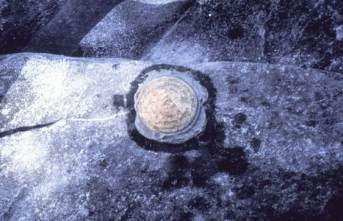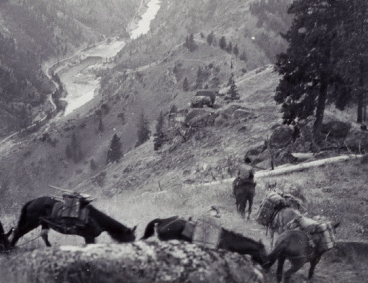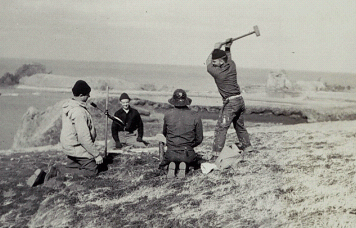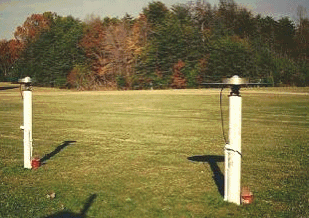 The
data collected by the National Geodetic Survey (NGS), and the resources
available through it, could rightly be called the basis for all geographic
information and mapping.The mission of the NGS is to " define and manage
a national coordinate system" otherwise known as the National Spatial Reference
System (NSRS).Established by Thomas Jefferson in 1807, and managed by
the National Oceanographic and Atmospheric Administration (NOAA), it was
the first civilian scientific agency.
The
data collected by the National Geodetic Survey (NGS), and the resources
available through it, could rightly be called the basis for all geographic
information and mapping.The mission of the NGS is to " define and manage
a national coordinate system" otherwise known as the National Spatial Reference
System (NSRS).Established by Thomas Jefferson in 1807, and managed by
the National Oceanographic and Atmospheric Administration (NOAA), it was
the first civilian scientific agency.
The importance of the NGS is fundamental to the national economic infrastructure. The NGS, as part of NOAA, is managed by the Department of Commerce.As such, it primary function is to provide the basis for all land mapping and coastal navigation.Without this information, roads would be misaligned and ships would find it difficult to find coastal channels deep enough for smooth passage.I think it is instructive to understand some of the ongoing projects that the NGS and what they provide to geospatial professionals. Here, now, is a short list of the projects that are undertaken by this agency (Source: NGS, NOAA):
National Spatial Reference System (NSRS): comprises a consistent, accurate, and up-to-date national shoreline; a network of continuously operating reference stations (CORS) which supports 3-dimensional positioning activities; a network of permanently marked points; and a set of accurate models describing dynamic, geophysical processes that affect spatial measurements.
The Federal Base Network: The Federal Base Network (FBN) is a nationwide network of permanently monumented stations spaced 100 kilometers apart with higher density in crustal motion areas.The FBN provides spatial reference control that has some of the most precise accuracies available today.Height Modernization Activities: NGS provides timely heights through technology such as Continuously Operating Reference Stations (CORS) and airborne remote sensing.It helps to allow aircraft to land safely in low-visibility conditions, and provide ships with safe under-keel and overhead clearance to avoid dangerous collisions, for example.
Continuously Operating Reference Stations (CORS): comprises a nationwide network of permanently operating Global Positioning System (GPS) receivers.NGS provides access to GPS data from this network free of charge via the Internet.The program's primary objective is to enable GPS users to determine precise positional coordinates relative to the National Spatial Reference System (NSRS).
NOAA Shoreline Data Explorer: The NOAA Shoreline Data Explorer is part of NGS's Coastal Mapping program.NGS is building a database of its digital shoreline holdings.Functions accessible through this location will support geographic browsing of the data base, and downloading of selected data to the user's computer.
National Ocean Service (NOS) MapFinder: The NOS MapFinder provides a map interface that retrieves a subset of NGS's control point datasheets and aerial photography in addition to many other National Ocean Services (NOS) products.
High Accuracy Reference Networks (HARNS) and The Readjustment of the National Spatial Reference System: The series of GPS surveys called HARNS were completed in 1998 to establish the Federal Base Network (FBN) and the Cooperative Base Network (CBN).These surveys were carried out on a state-by-state basis, leading to some inconsistencies at the borders between states.With the advent of the Continuously Operating Reference Stations (CORS) network in the mid-1990's, additional inconsistencies were discovered between the CORS and HARN (FBN/CBN) coordinates. From September 1997 through July 2003 NGS re-observed the Federal Base Network and in some cases assisted in re-observing and/or densifying the Cooperative Base Network (CBN).The purpose of this project was to improve the accuracy of the horizontal and ellipsoid height components of FBN stations. Accuracy requirements for these surveys were set to ensure 2-centimeter local accuracy in the horizontal component, as well as 2-centimeter local accuracy in the ellipsoid heights.
Online Positioning User Service (OPUS): The National Geodetic Survey operates the On-line Positioning User Service (OPUS) as a means to provide GPS users easier access to the National Spatial Reference System (NSRS).OPUS allows users to submit their GPS data files to NGS, where the data will be processed to determine a position using NGS computers and software. Each data file that is submitted will be processed with respect to 3 CORS sites. The sites selected may not be the nearest to your site but are selected by distance, # of obs, site stability, etc. The position for your data will be reported back to you via email in both ITRF and NAD83 coordinates as well as UTM, USNG and State Plane Coordinates (SPC) northing and easting.
GEOID03 is a refined model of the geoid in the conterminous United States (CONUS), which supersedes the previous models GEOID90, GEOID93, GEOID96, and GEOID99. For CONUS, GEOID03 heights range from a low of -50.01 meters (magenta) in the Atlantic Ocean to a high of 3.43 meters (red) in the Labrador Strait. However, these geoid heights are only reliable within CONUS due to the limited extents of the data used to compute it.GEOID03 models will not be created for other regions.Instead, new models will be created next year (GEOID04) for all U.S.states and territories.
NGS and NOAA also maintain an historical library of photographic
which readers may find interesting.Please see the following:


